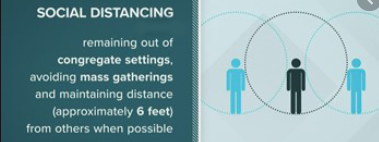March 17th, 2020
BURLINGTON, ON
The Province declared a State of Emergency this morning and put a number of requirements in place.
These measures are an attempt to enforce distance between people, a proven way to slow pandemics.
Experts have also been urging people to practice voluntary “social distancing.” The term has been trending on Twitter, with even President Trump endorsing it on Saturday.
Still, people all over the United States have been out in large numbers at restaurants, bars and even sporting events, suggesting more than a little confusion around what social distancing is and who should be practicing it.
This is deeply worrying, experts said, because even those who become only mildly ill — and maybe even those who never even know they are infected — can propel the exponential movement of the virus through the population.
They emphasized that it’s important for everyone to practice social distancing, not just those considered to be at high risk or who are seriously ill.
“These are not normal times, this is not a drill, we have never been through anything like this before” said the Ontario Medical Officer of Health.
What exactly is social distancing? We asked experts for practical guidance.
What is social distancing?
Put simply, the idea is to maintain a distance between you and other people — in this case, at least six feet.
That also means minimizing contact with people. Avoid public transportation whenever possible, limit nonessential travel, work from home and skip social gatherings — and definitely do not go to crowded bars and sporting arenas.
“Every single reduction in the number of contacts you have per day with relatives, with friends, co-workers, in school, will have a significant impact on the ability of the virus to spread in the population,”
This strategy saved thousands of lives both during the Spanish flu pandemic of 1918 and, more recently, in Mexico City during the 2009 flu pandemic.
I’m young and don’t have any risk factors. Can I continue to socialize?
Please don’t. There is no question that older people and those with underlying health conditions are most vulnerable to the virus, but young people are by no means immune.
And there is a greater public health imperative. Even people who show only mild symptoms may pass the virus to many, many others — particularly in the early course of the infection, before they even realize they are sick.
So you might keep the chain of infection going right to your own older or high-risk relatives. You may also contribute to the number of people infected, causing the pandemic to grow rapidly and overwhelm the health care system.
If you ignore the guidance on social distancing, you will essentially put yourself and everyone else at much higher risk.
Experts acknowledge that social distancing is tough, especially for young people who are used to gathering in groups. But even cutting down the number of gatherings, and the number of people in any group, will help.
Can I leave my house?
Absolutely. The experts were unanimous in their answer to this question.
When you do leave your home, wipe down any surfaces you come into contact with, disinfect your hands with an alcohol-based sanitizer and avoid touching your face. Above all, frequently wash your hands — especially whenever you come in from outside, before you eat or before you’re in contact with the very old or very young.
Can I go to the supermarket?
Yes. But buy as much as you can at a time in order to minimize the number of trips, and pick a time when the store is least likely to be crowded.
When you do go, be aware that any surface inside the store may be contaminated. Use a disinfecting wipe to clean the handle of the grocery cart, for example. Experts did not recommend wearing gloves, but if you do use them, make sure you don’t touch your face until you have removed the gloves.
Dr. Caitlin Rivers, an epidemiologist at Johns Hopkins University, recommends stowing your cellphone in an inaccessible place so that you don’t absent-mindedly reach for it while shopping. “That could be a transmission opportunity,” she said.
If it’s a long shopping trip, you may want to bring hand sanitizer with you and disinfect your hands in between. And when you get home, wash your hands right away.
Those at high risk may want to avoid even these outings if they can help it, especially if they live in densely populated areas.
Dr. Marrazzo said her mother is an “incredibly healthy” 93-year-old who usually drives herself to the store, but she said she has asked her mother not to go out during this time, because “the risks are too great given the age-related mortality we’re seeing.”

This is what we need to do every time there is a line up – this is what stops the spread of the virus.
It’s O.K. to go outdoors for fresh air and exercise — to walk your dog, go for a hike or ride your bicycle, for example. The point is not to remain indoors, but to avoid being in close contact with people.
You may also need to leave the house for medicines or other essential resources. But there are things you can do to keep yourself and others safe during and after these excursions.
When you do leave your home, wipe down any surfaces you come into contact with, disinfect your hands with an alcohol-based sanitizer and avoid touching your face. Above all, frequently wash your hands — especially whenever you come in from outside, before you eat or before you’re in contact with the very old or very young.
Can family come to visit?
That depends on who is in your family and how healthy they are.
“Certainly, sick family should not visit,” said Dr. Marrazzo. “If you have vulnerable people in your family, or who are very old, then limit in-person contact.”
But if everyone in the family is young and healthy, then some careful interaction in small groups is probably OK. “The smaller the gathering, the healthier the people are to start with, the lower the risk of the situation is going to be,” she said.
At the same time, you don’t want family members to feel isolated or not have the support of loved ones, so check in with them by phone or plan activities to do with them on video.
Can I take my kids to the playground?
That depends. If your children have any illness, even if it’s not related to the coronavirus, keep them at home.
If they seem healthy and desperately need to burn energy, outdoor activities such as bike rides are generally OK. But “people, especially in higher-risk areas, may want to think twice about trips to high-traffic public areas like the playground,” said Dr. Neha Chaudhary, a psychiatrist at Harvard Medical School.
Kids also tend to touch their mouths, noses and faces constantly, so parks or playgrounds with few kids and few contaminated surfaces are ideal. Take hand sanitizer with you and clean any surfaces with disinfecting wipes before they play.
Serious illness from this virus in kids is rare, so the kids themselves might be safe. “That doesn’t mean they can’t come home and give it to Grandma,” said Dr. Marazzo.
So kids should wash their hands often, especially before they come into contact with older or high-risk family members.
 I’m scared to feel alone. Is there anything I can do to make this easier?
I’m scared to feel alone. Is there anything I can do to make this easier?
It’s a scary and uncertain time. Staying in touch with family and friends is more important than ever, because we are biologically hard-wired to seek each other out when we are stressed, said Dr. Jonathan Kanter, director for the Center for Science of Social connection at the University of Washington in Seattle.
Dr. Kanter said he was particularly worried about the long-term impact of social isolation on both the sick and the healthy. The absence of physical touch can have a profound impact on our stress levels, he said, and make us feel under threat.
He said even imagining a warm embrace from a loved one can calm the body’s fight-or-flight response.
In the meantime, we are lucky enough to have technologies at hand that can maintain social connections. “It’s important to note that social distancing does not mean social isolation,” Dr. Chaudhary said.
She suggested people stay connected via social media, chat and video. Be creative: Schedule dinners with friends over FaceTime, participate in online game nights, plan to watch television shows at the same time, enroll in remote learning classes. It’s especially important to reach out to those who are sick or to high-risk people who are self-isolating. “A phone call with a voice is better than text, and a video chat is better than a telephone call,” Dr. Kanter said.
How long will we need to practice social distancing?
That is a big unknown, experts said. A lot will depend on how well the social distancing measures in place work and how much we can slow the pandemic down. But prepare to hunker down for at least a month, and possibly much longer.
In British Columbia, the recommendations on social distancing have continued to escalate with the number of infections and deaths, and as the health system has become increasingly strained.
“For now, it’s probably indefinite,” Dr. Marrazzo said. “We’re in uncharted territory.”





















As an example of the uphill battle our officials are facing: yesterday I was in Shoppers to top up needed prescriptions. Five senior people were gathered near the door, having an animated discussion about … I don’t know for sure, but it sounded like the current restrictions might be the topic … 15 minutes later they were still at it. Face to face, 3 feet apart, emoting into each others faces. And anyone who had to pass them to get in the store. Meanwhile, at the pharmacy, many workers were wearing face masks — including one who had pulled their mask down to talk on the telephone.
Go figure.
Perryb